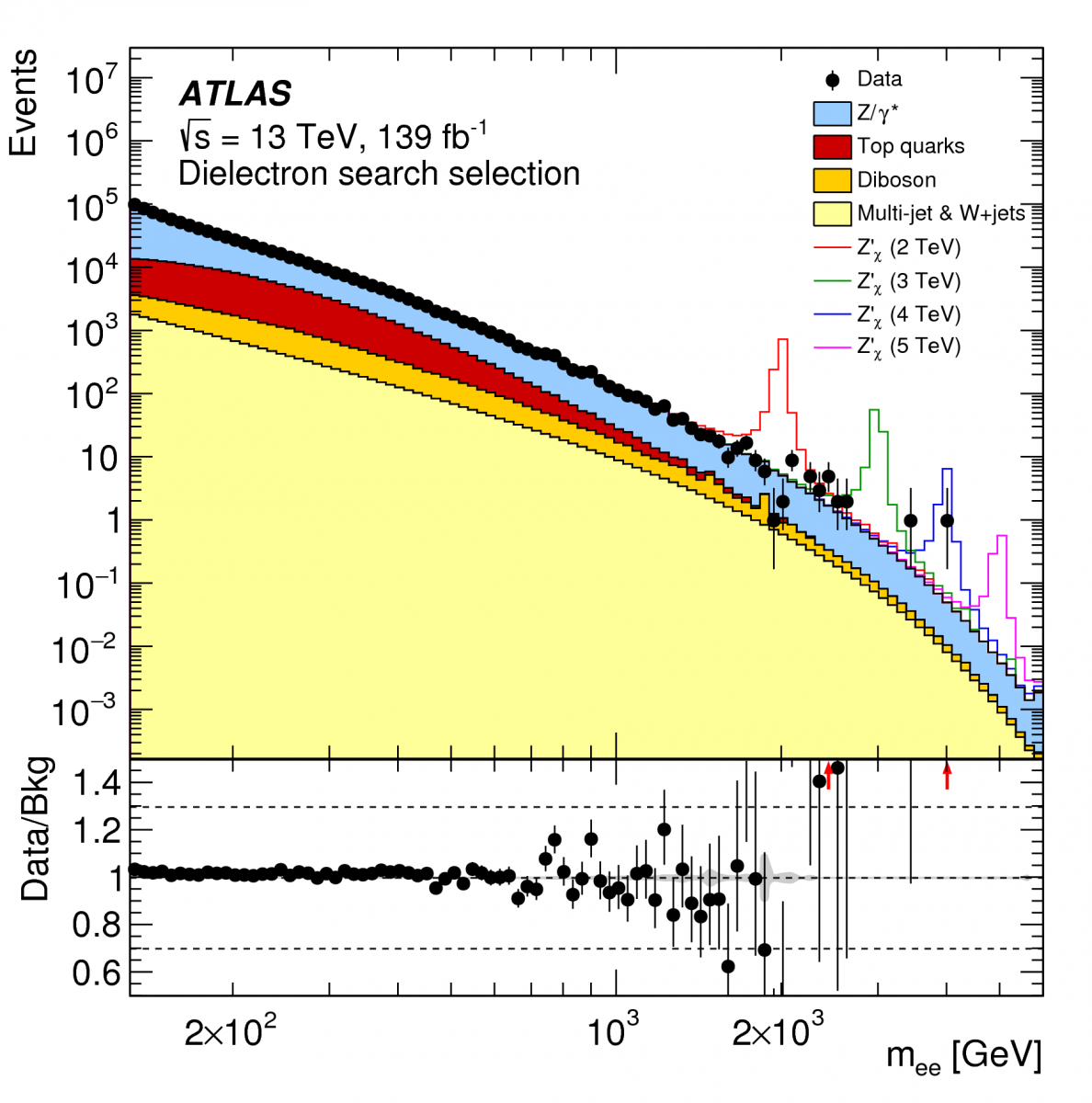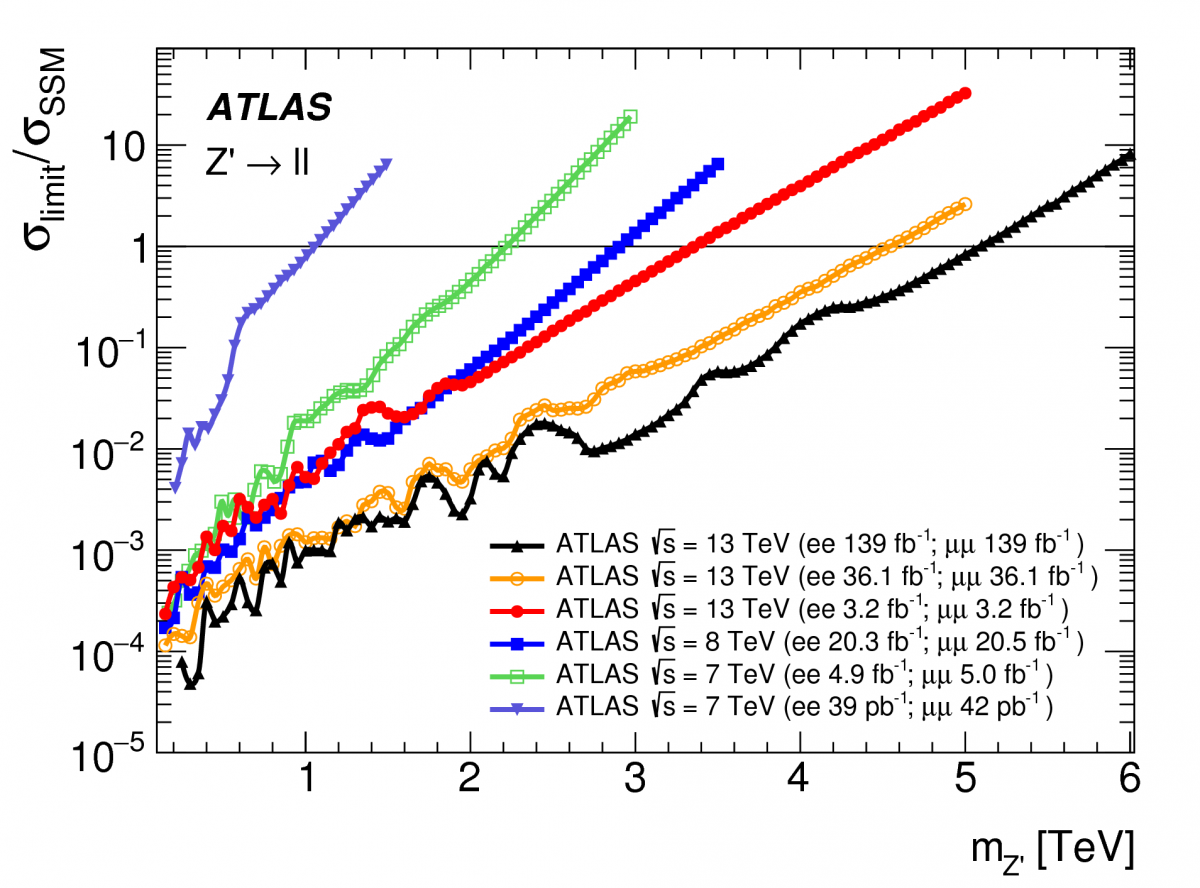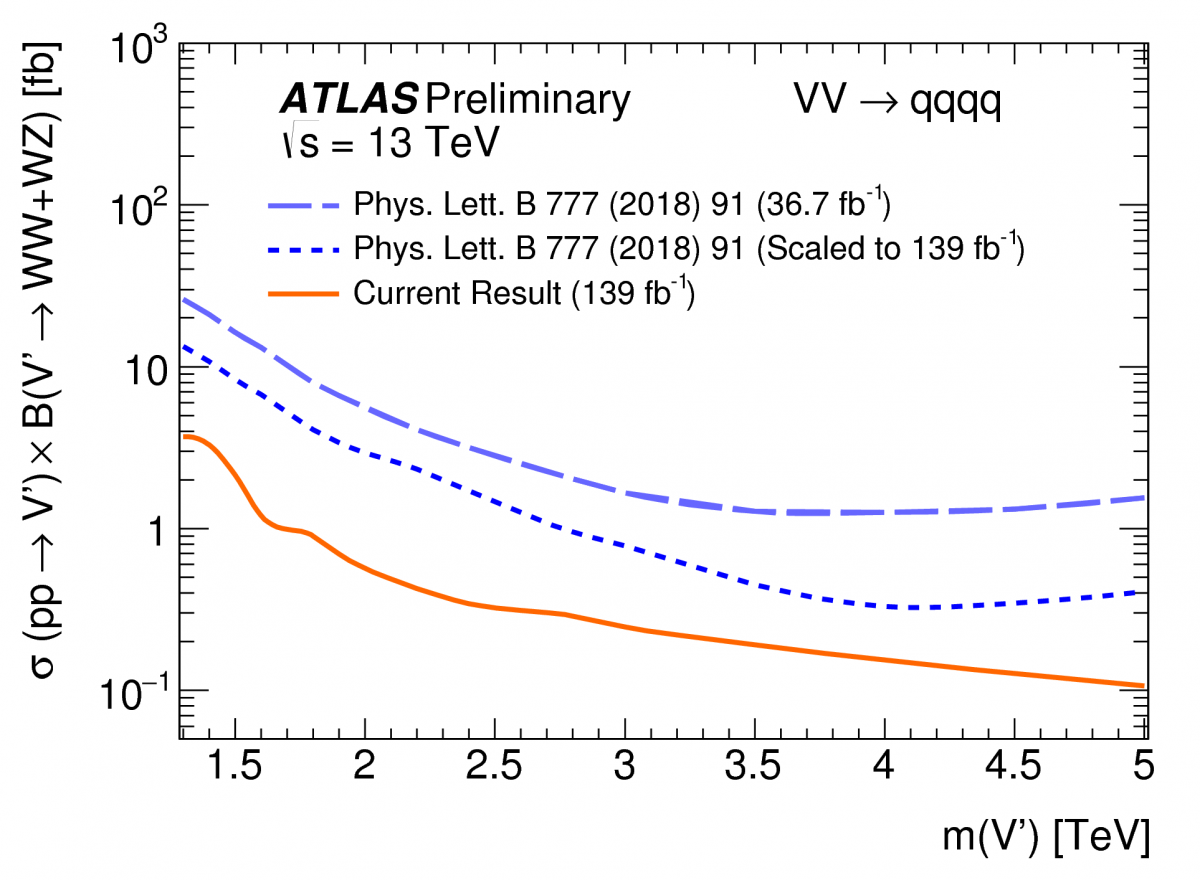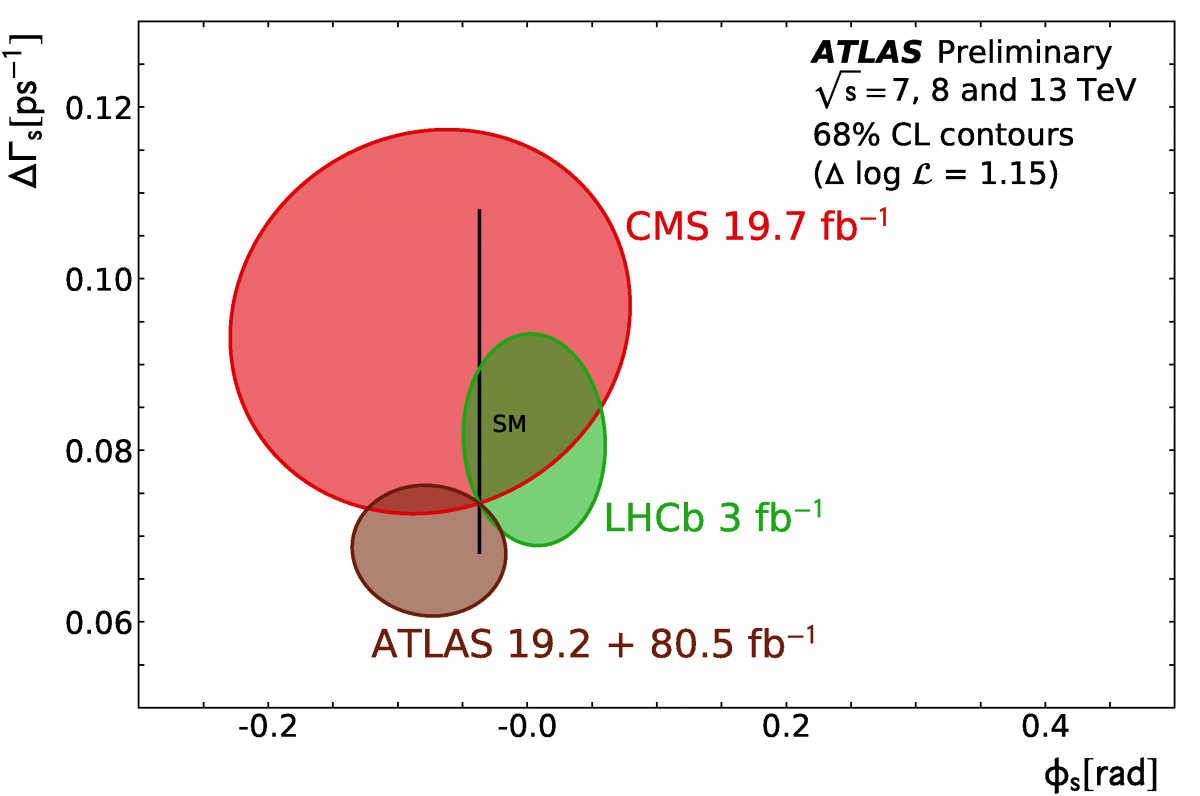Highlights from Moriond: ATLAS explores the full Run-2 dataset
23 March 2019 | By
This week, particle physicists from around the world gathered in La Thuile, Italy, for the annual Rencontres de Moriond conference on Electroweak Interactions and Unified Theories. It was one of the first major conferences to be held following the recent completion of the Large Hadron Collider’s (LHC) second operation period (Run 2). The ATLAS Collaboration unveiled a wide range of new results, including new analyses using the full Run-2 dataset, as well as some high-profile studies of Higgs, electroweak and heavy-ion physics.
First search results using the full Run-2 dataset

Over the course of Run 2 of the LHC – from 2015 to 2018 – the ATLAS experiment collected 139 inverse femtobarn of proton-proton collision data for analysis. Though this data-taking period concluded just a few months ago, ATLAS physicists have already reported on a variety of new searches using the full Run-2 dataset. So far, all of these new searches are in agreement with the Standard Model expectation.
The first of these analyses, released in a paper submitted to Physics Letters B, is a search for heavy neutral gauge bosons (denoted Z’) decaying into lepton pairs. The sensitivity of this analysis has increased significantly over the lifetime of the LHC, as seen in Figure 3. The new result sets exclusion limits on specific theoretical models up to a mass of 5.1 TeV.
A similar search was also conducted by looking for new particles – or “resonances” – decaying to two jets of particles. These “dijet” searches reveal events with the highest energies observed at the LHC; an example of such an event can be seen in Figure 1. No evidence of significant resonant structures was observed in the mass spectrum probed with the Run-2 dataset.
ATLAS physicists also presented a search for new particles decaying to two weak bosons (W of Z), where the weak bosons then decay to two jets each. As the resonance would be very heavy, the weak bosons produced would be highly energetic and would generate overlapping jets as they decay. Thus, identifying the weak bosons is particularly challenging, and required the development of new reconstruction and analysis techniques. These have substantially improved the sensitivity of the analysis, as illustrated in Figure 4, setting significantly improved constraints on the allowed parameter space for such heavy resonances decaying to W or Z bosons.
New searches for supersymmetry were also presented. One analysis focused on electroweak production of supersymmetric particles called “charginos” and “sleptons” decaying into two electrons or muons, along with missing transverse momentum. A second analysis looked for long-lived supersymmetric partners of the top quark that decay further away from the collision point. Many other searches are ongoing at ATLAS that will probe vast regions of yet-unexplored supersymmetric parameter space.


First measurement of the Higgs boson using the full Run-2 dataset
ATLAS also released a new measurement of the rare production cross section of the Higgs boson in association with two top quarks (ttH), followed by the similarly rare decay of the Higgs boson to two photons. The ttH production process was first observed in 2018, though it required the combination of many Higgs decay channels. Using the full Run-2 dataset, the observation of ttH in a single Higgs decay channel – into a pair of photons – is now possible. This allowed for a measurement of the production rate with an uncertainty of 25%, with a central value that is compatible with the Standard Model prediction.
An updated combination of Higgs analyses was also presented, setting new constraints on the Higgs coupling to other particles, as well as interesting indirect constraints on the elusive self-coupling of the Higgs boson with itself. This update includes analyses that use 80 fb-1 (the data taken from 2015 to 2017) and represents the most comprehensive and precise set of Higgs properties measurements presented by the collaboration to date. Other results reporting first evidence for the rare electroweak processes involving the production of three weak bosons were also shown at the conference.
Observation of light-by-light scattering
The scattering of light by light involves two incoming photons scattering off of each other and producing two outgoing photons. This is a purely quantum mechanical effect that is not predicted by the classical theory of electromagnetism. The scattering of light requires a very intense source of photons, which can be achieved by using the enormous electric fields generated by fully ionised lead ions. As the ions cross each other, the intense electric fields supply a beam of photons that can collide, effectively turning the Large Hadron Collider into a “Large Photon Collider”.
Evidence for this process at the LHC was first reported by ATLAS in 2017 in Nature Physics, and was also seen by CMS. Using the much larger dataset collected in 2018, ATLAS was able to clearly observe this process with a significance of over 8 standard deviations and measure the cross section with an uncertainty of 19%. This was one of the first results presented at Moriond.
New measurement of CP violation

The observed asymmetry between matter and antimatter in the Universe (a symmetry breaking known as “CP violation”) is one the unresolved puzzles in particle physics. As the Standard Model is only able to explain part of this asymmetry, there is great motivation to search for additional sources in the form of new or larger CP violation phases. The LHC produces copious samples of B mesons that are used to measure CP violating processes. In a new analysis using 80 fb-1 of data, ATLAS investigated the decay of B-sub-s (Bs) mesons, which are composed of a bottom quark and a strange quark. Specifically, J/ψ φ decays were investigated to measure the CP-violating phase φs, the average decay width (Γs), and the width difference (∆Γs) between the physical Bs meson states.
In the Standard Model, φs is predicted to be small. However, physics beyond the Standard Model could increase the size of the observed CP violation by enhancing the mixing phase φs with respect to the Standard Model value. The measured values of φs and ∆Γs are shown in Figure 5, and compared to measurements by other LHC experiments and to the Standard Model prediction.
A week of rich and exciting results
This week, ATLAS and other LHC experiments presented important new results, deepening our understanding of particle physics. The presentation of the first results with the full Run-2 dataset represent the first steps in the realisation of what will be a rich and exciting Run 2 physics programme. Though Moriond EW is now drawing to a close, the Moriond QCD conference will start on its heels on Sunday 24 March – expect more exciting new results.
Learn more
- First ATLAS result with full Run-2 dataset: a search for new heavy particles, Physics Briefing
- ATLAS measures Higgs boson coupling to top quark in diphoton channel with full Run-2 dataset, Physics Briefing
- All together now: adding more pieces to the Higgs boson puzzle, Physics Briefing
- ATLAS finds evidence of three massive vector boson production, Physics Briefing
- Search for high-mass dilepton resonances using 139 fb−1 of proton-proton collision data collected at 13 TeV with the ATLAS detector (arXiv: 1903.06248, see figures)
- Search for New Phenomena in Dijet Events using 139 fb−1 of proton-proton collisions at 13 TeV collected with the ATLAS Detector (ATLAS-CONF-2019-007)
- Search for diboson resonances in hadronic final states in 139 fb−1 of proton-proton collisions at 13 TeV with the ATLAS detector (ATLAS-CONF-2019-003)
- Measurement of the CP violation phase ϕs in B0s→J/ ψϕ decays in ATLAS at 13 TeV (ATLAS-CONF-2019-009)
- Evidence for the production of three massive vector bosons in proton-proton collisions with the ATLAS detector (STDM-2017-22)




